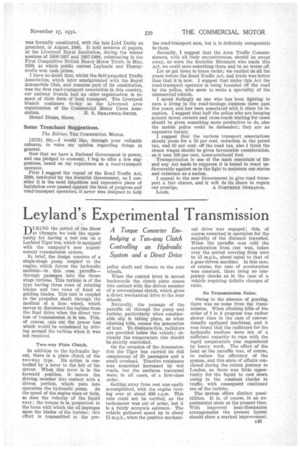Leyland's Experimental Transmission
Page 67

If you've noticed an error in this article please click here to report it so we can fix it.
A Torque Converter Embodying a Two-way Clutch Controlling an Hydraulic System and a Direct Drive
TAURING the period of the Show LI at Olympia we took the opportunity for having a test run on a Leyland Tiger bus, which is equipped with the company's new experimental transmission system.
In brief, the design consists of a single-stage pump coupled to the engine, which forces the hydraulic medium—in this case paraffin— through passages into the threestage turbine. This turbine is of the type having three rows of rotating blades and two rows of fixed or guiding blades. This unit is coupled to the propeller shaft through the medium of a freewheel, which serves to disconnect the turbine from the final drive when the direct system of transmission is in use. This, of course, cuts out the Dower loss which would be occasioned by driving around the turbine when it was not required.
Two-way Plate Clutch.
In addition to the hydraulic layout, there is a plate clutch of the two-way type. Its action is controlled by a lever to the left of the driver. When this lever is in the forward position, it moves the driving member into contact with a driven portion, which puts into operation the hydraulic pump. As the speed of the engine rises or falls, so does the velocity of the liquid 'vary ; the torque is in proportion to the force with which the oil impinges upon the blades of the turbine ; this effort is transmitted to the pro peller shaft and thence to the rear wheels.
When the control lever is moved backwards the clutch plate comes into contact with the driven member of a conventional clutch, which gives a direct mechanical drive to the rear wheels.
Naturally, the passage of the paraffin oil through the pump and turbine, particularly when considerable slip is taking place, as when climbing hills, causes the generation of heat. To dissipate this, radiators are provided below the vehicle ; obviously the temperature rise should be strictly controlled.
On the occasion of the demonstration the Tiger bus carried its full complement of 35 pasengers and a small overload. Tractive resistance was somewhat increased by wet roads, hut the surfaces traversed were, in all cases, of a first-class order.
Getting away from rest was easily accomplished, with the engine turning over at about 600 r.p.m. This rate could not be verified, as the tachometer was out of order, but it is a fairly accurate estimate. The vehicle gathered speed up to about 15 m.p.h., when the positive mechani cal drive was engaged ; this, of course remained in operation for the majority of the distance travelled. When the paraffin -was cold the acceleration from rest was, taken over the period covering from zero to 15 m.p.h., about equal to that of a gear-driven machine. In this ease, of course, the rate of acceleration was constant, there being no temporary checks as in the case of a vehicle requiring definite changes of ratio.
No Transmission Noise.
Owing to the absence of gearing, there was no noise from the transmission. When climbing hills of the order of 1 in 8 progress was rather slower than in the case of conventionally equipped machines, and it was found that the radiators for the hydraulic medium were not of a sufficient capacity to cope with the rapid temperature rise engendered by heavy work. The effect of the heat on the paraffin was, of course, to reduce the efficiency of the system, and this state of affairs continued during the return journey to London, as there was little opportunity for the liquid to cool down owing to the constant checks in traffic, with consequent continued use of the turbine.
The system offers distinct possibilities. It is, of course, in an ex perimental state at the present time. With improved heat-dissipation arrangements the present layout should show a marked improvement.












































































































